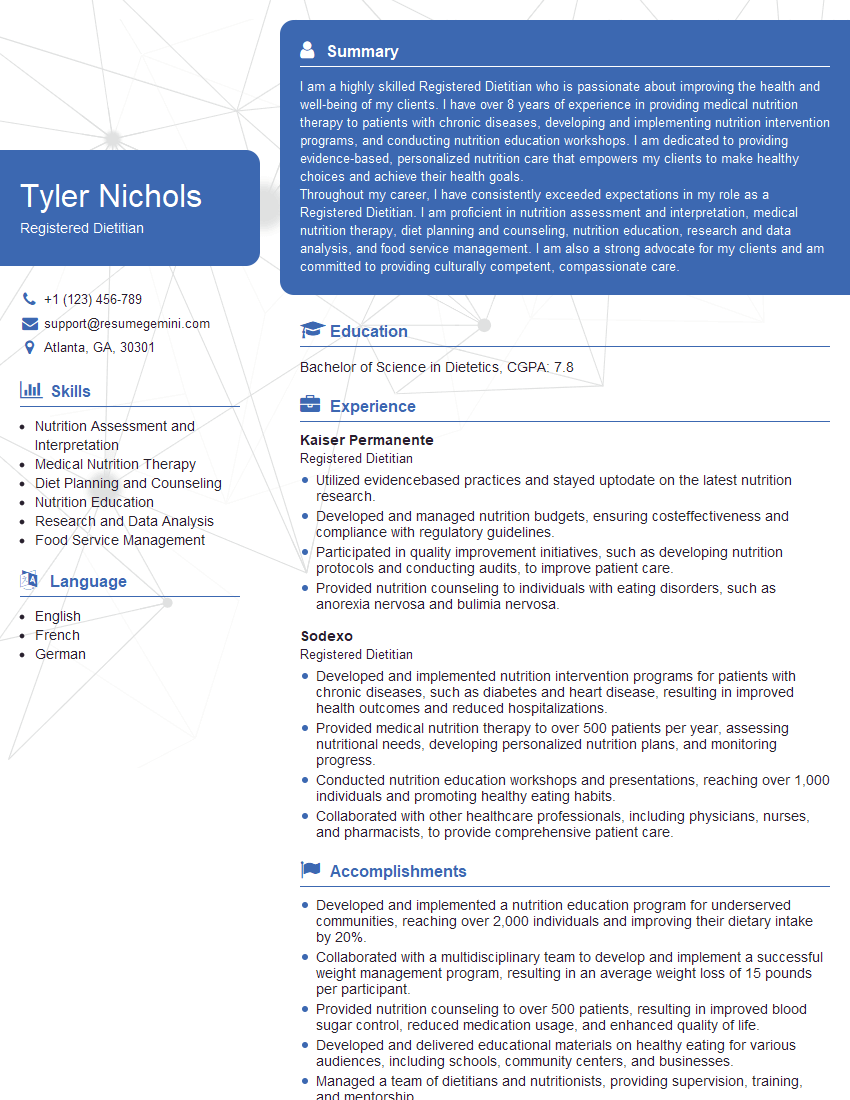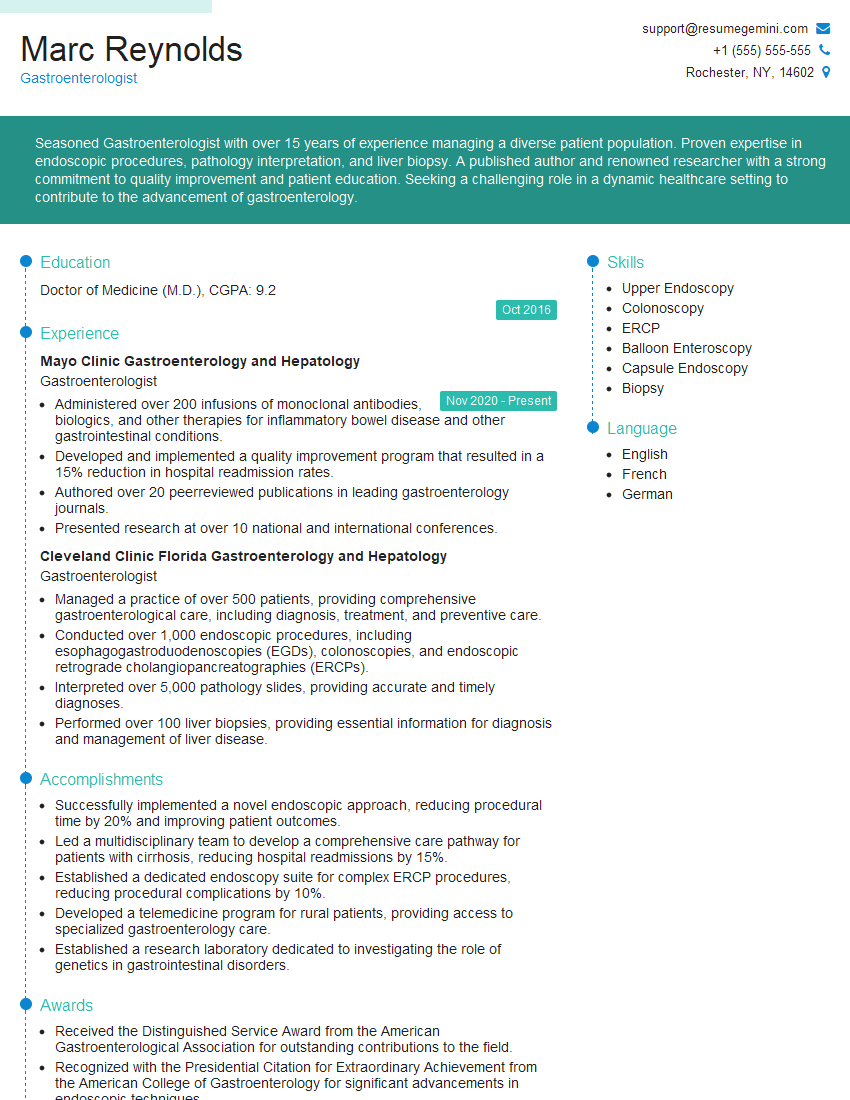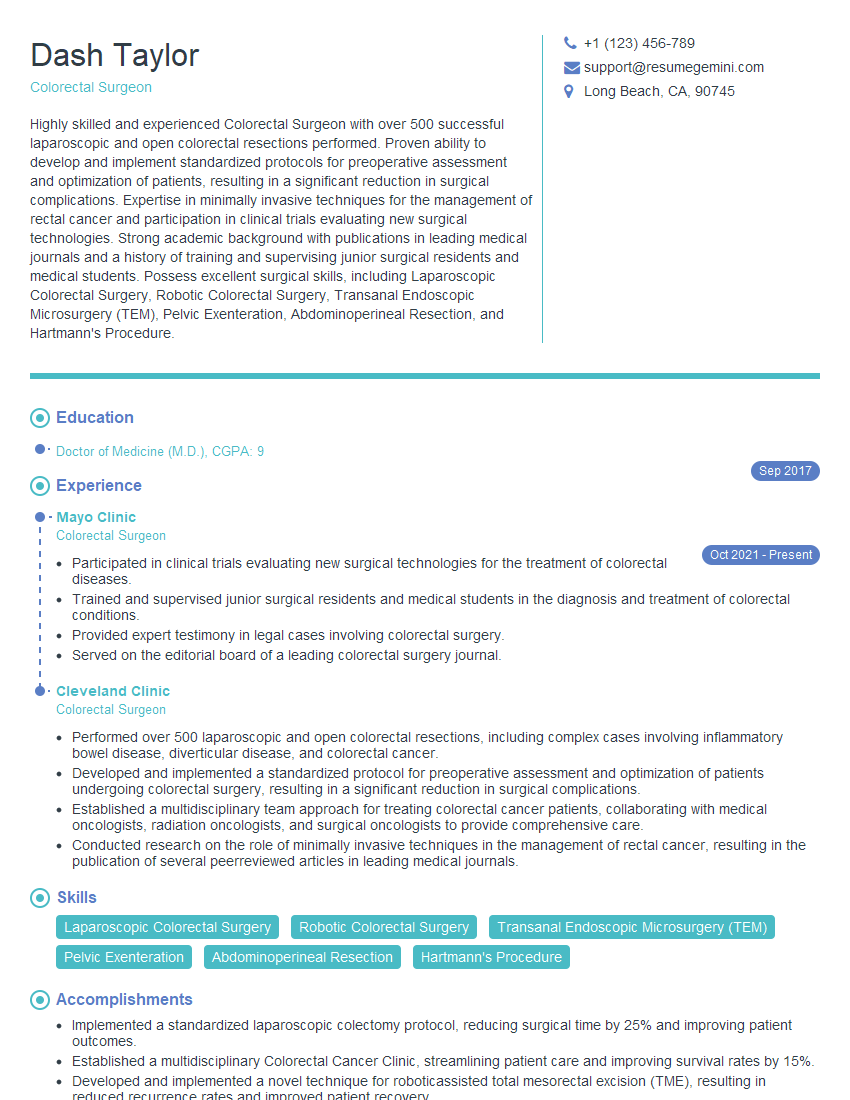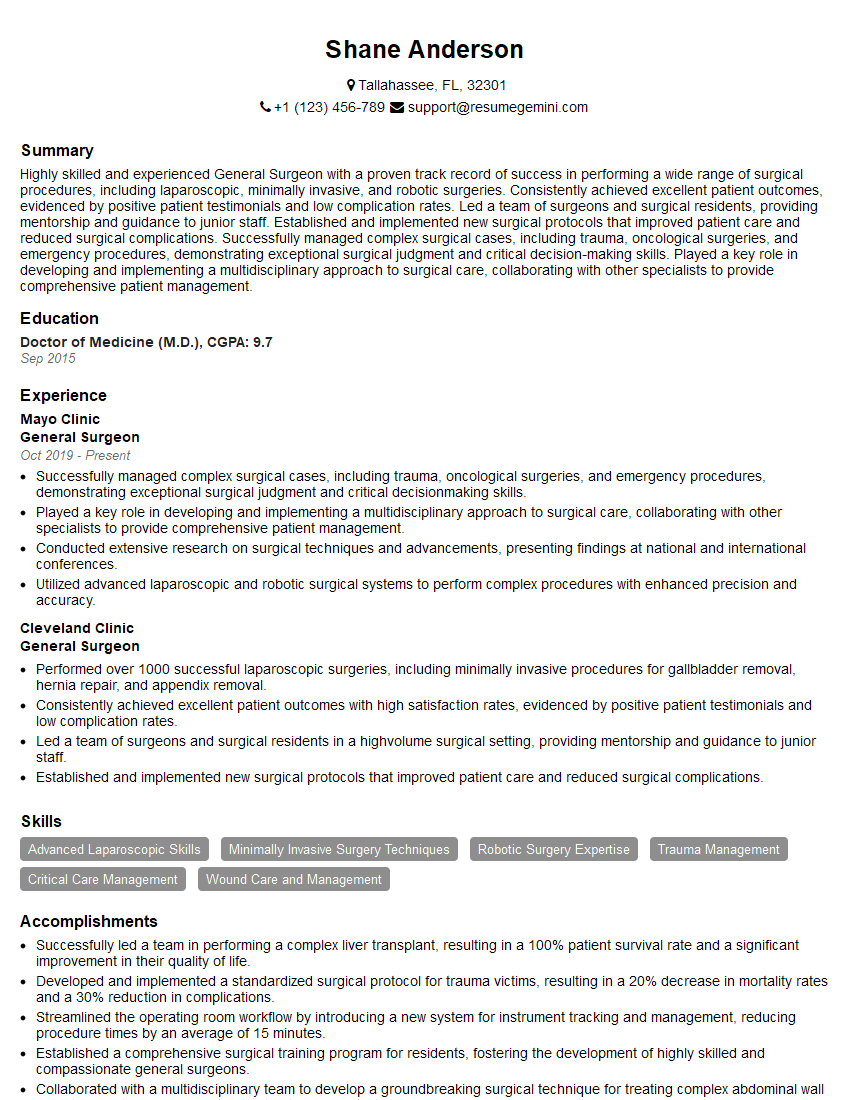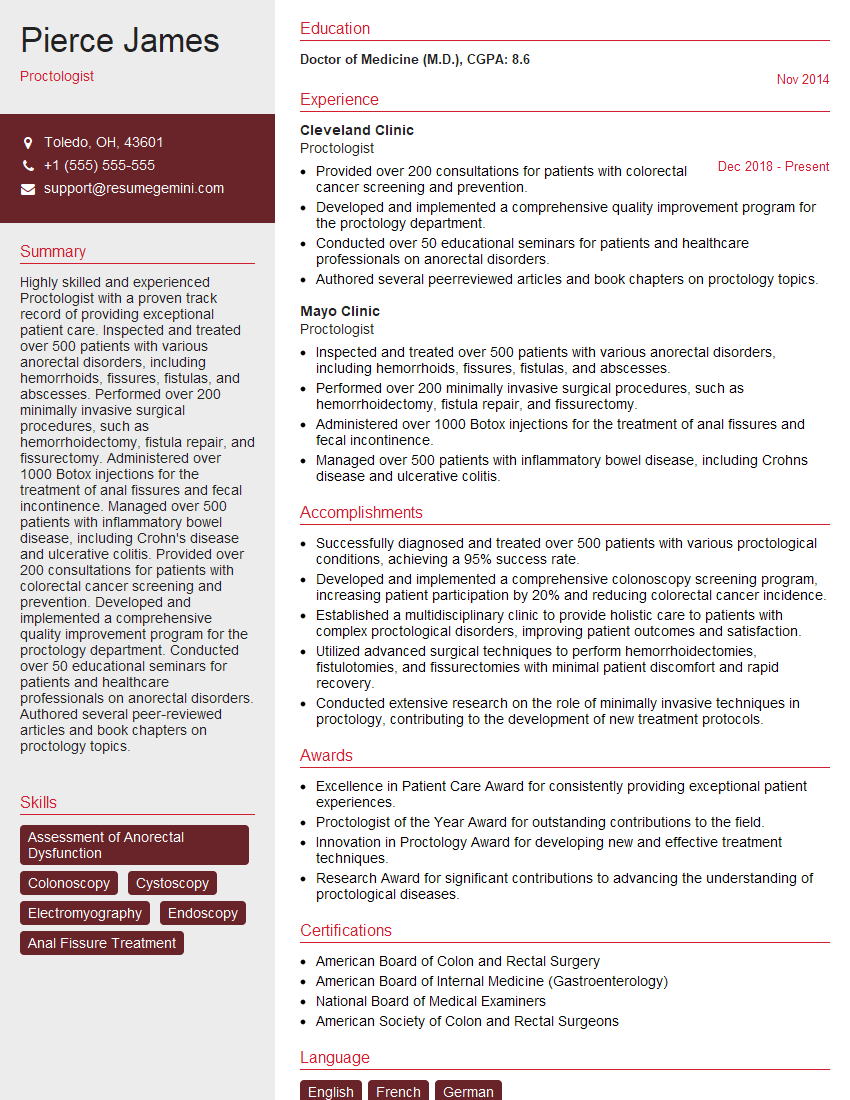Interviews are more than just a Q&A session—they’re a chance to prove your worth. This blog dives into essential Anal Fissure Treatment interview questions and expert tips to help you align your answers with what hiring managers are looking for. Start preparing to shine!
Questions Asked in Anal Fissure Treatment Interview
Q 1. Describe the pathophysiology of an anal fissure.
Anal fissures are tears in the lining of the anal canal, typically occurring in the posterior midline. The pathophysiology is multifaceted, but it primarily involves a disruption of the delicate balance between the anal canal’s internal and external sphincters. Increased pressure during bowel movements, often from hard stools or straining, leads to trauma to the anal mucosa. This trauma, initially a superficial tear, can progress to a deeper fissure. The lack of adequate blood supply to the area, worsened by the constant stretching and trauma, can further impede healing. The resulting inflammation perpetuates a cycle of pain and spasm, hindering natural repair.
Think of it like a paper cut that won’t heal properly because you keep reopening it. The constant spasm of the anal sphincter prevents blood flow, which is vital for tissue repair. This leads to the formation of a sentinel pile (a small skin tag) at the fissure’s edge and a hypertrophied anal papilla (an enlarged anal tissue). These are classic signs of a chronic fissure.
Q 2. Differentiate between acute and chronic anal fissures.
The key difference lies in duration and healing. An acute anal fissure is a recent tear, usually less than six weeks old. It’s characterized by relatively quick healing with conservative measures. Think of it as a fresh cut that’s likely to heal with proper care. In contrast, a chronic anal fissure persists for over six weeks. This is because the constant anal sphincter spasm prevents the fissure from healing. Chronic fissures are often associated with a sentinel pile and hypertrophied anal papilla, reflecting the persistent inflammation and impaired blood flow.
Q 3. What are the common symptoms of an anal fissure?
The most prominent symptom is sharp, tearing pain during bowel movements. This pain can be excruciating and may persist for several minutes afterward. Bleeding is also common, typically bright red blood on the stool or toilet paper. Patients may also experience itching, spasm, and discomfort in the anal area. In chronic cases, the pain may become more constant and less intense, but still significant. The sensation of incomplete bowel emptying might also be present.
Imagine the sharp pain of a paper cut, but intensified and prolonged. This, combined with bleeding and persistent discomfort, can significantly impact a person’s quality of life.
Q 4. Explain the diagnostic methods used to identify anal fissures.
Diagnosis of anal fissures is typically straightforward. A thorough history from the patient, detailing the symptoms, is crucial. The physical examination, particularly a visual inspection of the anal area, is often sufficient. The physician will look for the fissure itself, the sentinel pile, and hypertrophied anal papilla. An anoscopy, a procedure involving the insertion of a short, thin tube with a light to visualize the anal canal, might be used to get a better view, especially for deeper fissures or to rule out other conditions.
In most cases, a simple visual examination is all that is needed, similar to assessing a simple wound. However, in complex cases, an anoscopy helps provide a more detailed picture.
Q 5. Outline the conservative management strategies for anal fissures.
Conservative management focuses on promoting healing by addressing the underlying causes and relieving symptoms. This typically involves:
- High-fiber diet and increased fluid intake: To soften stools and reduce straining.
- Topical medications: Such as nitroglycerin ointment or diltiazem cream to relax the anal sphincter and improve blood flow.
- Sitz baths: Warm water baths to soothe the area and promote healing.
- Stool softeners: To further reduce straining during bowel movements.
- Pain management: Using over-the-counter analgesics like acetaminophen or ibuprofen for pain relief.
The goal is to create a healing environment by softening stools, reducing sphincter spasm, and managing pain. Think of it as providing optimal conditions for the wound to heal naturally.
Q 6. What are the indications for surgical intervention in anal fissure treatment?
Surgical intervention is usually reserved for chronic anal fissures that haven’t responded to conservative management for at least six to eight weeks. Indications include:
- Persistent, debilitating pain despite conservative measures.
- Significant bleeding.
- Presence of a significant sentinel pile or hypertrophied anal papilla indicating chronic inflammation.
- Failure to heal despite optimized bowel habits and medication.
Essentially, if conservative treatments fail to improve the patient’s condition significantly, surgery becomes a viable option. This is a last resort when quality of life is significantly impacted.
Q 7. Describe the surgical techniques used to treat anal fissures (e.g., lateral internal sphincterotomy).
The most common surgical technique is lateral internal sphincterotomy (LIS). This procedure involves a small incision in the internal anal sphincter muscle, releasing the spasm and improving blood flow to the fissure. This allows for quicker healing and pain relief. It’s a relatively straightforward procedure performed under local or general anesthesia. The incision is small and strategically placed to minimize the risk of incontinence. Other procedures, such as botulinum toxin injection (to relax the sphincter) or advancement flaps (to cover the fissure), may also be used in specific cases, but LIS remains the gold standard for surgical management.
Think of LIS as a targeted ‘repair’ that releases the tension and allows for healing. While it carries a slight risk of incontinence, this risk is usually minimal and often outweighs the benefits of eliminating chronic pain and improving quality of life.
Q 8. Explain the potential complications associated with lateral internal sphincterotomy.
Lateral internal sphincterotomy (LIS) is a surgical procedure used to treat chronic anal fissures. While highly effective, it carries potential complications. The most significant is incontinence, specifically for flatus (gas) or stool. This occurs because the procedure involves cutting a small portion of the internal anal sphincter muscle, which plays a crucial role in maintaining continence. The severity of incontinence varies greatly; some patients experience only minor changes, while others may experience more significant issues.
Other potential complications include:
- Bleeding: Minor bleeding is common, but significant bleeding requiring further intervention is rare.
- Infection: Infection at the surgical site is possible, though typically managed with antibiotics.
- Pain: Post-operative pain is expected, but typically manageable with medication. However, in some cases, it can be severe and persistent.
- Wound Healing Complications: Delayed healing or wound breakdown is uncommon but can occur.
- Recurrent Fissure: While less frequent, the fissure can recur in a small percentage of cases.
It’s crucial to carefully weigh the risks and benefits of LIS with each patient, considering factors such as fissure severity and the patient’s age and overall health. Conservative management is always attempted first.
Q 9. Discuss the role of botulinum toxin injection in anal fissure treatment.
Botulinum toxin type A (Botox) injection is a minimally invasive treatment option for anal fissures. It works by relaxing the internal anal sphincter muscle, reducing pressure and spasm, and thereby promoting healing. The injection is performed in the office setting, usually under local anesthesia. This targeted muscle relaxation reduces pain and improves blood flow to the fissure, facilitating healing.
The success rate of Botox for anal fissure treatment is relatively high in the short term, though long-term efficacy may vary. It is often considered a first-line treatment option for patients who aren’t suitable candidates for surgery or prefer a less-invasive approach.
Q 10. What are the advantages and disadvantages of botulinum toxin injection compared to surgery?
Botox injection and surgery (LIS) both aim to relieve anal fissure symptoms but differ significantly in invasiveness and potential complications.
Botox Injection Advantages:
- Minimally invasive, performed in the office setting.
- Less post-operative pain and recovery time.
- Lower risk of incontinence compared to LIS.
Botox Injection Disadvantages:
- May not be as effective as LIS in long-term healing.
- Effect is temporary; multiple injections may be needed.
- Can be slightly more expensive initially, especially if multiple treatments are required.
Surgery (LIS) Advantages:
- Higher success rate for long-term healing.
- Usually a one-time procedure.
Surgery (LIS) Disadvantages:
- More invasive, requiring hospitalization or a same-day surgery center stay.
- Higher risk of complications, including incontinence.
- Longer recovery period and greater post-operative pain.
The choice between Botox and surgery is individualized and depends on the patient’s specific circumstances, preferences, and the severity of their fissure.
Q 11. How do you manage post-operative pain and discomfort after anal fissure surgery?
Post-operative pain management is crucial for patient comfort and successful recovery after anal fissure surgery. A multimodal approach is often used, combining different methods to optimize pain relief.
This might include:
- Analgesics: Oral pain medications such as acetaminophen (Tylenol) or non-steroidal anti-inflammatory drugs (NSAIDs) like ibuprofen are frequently prescribed. In cases of severe pain, opioids may be used short-term.
- Topical anesthetics: Creams or ointments containing lidocaine can provide local pain relief.
- Sitz baths: Warm water soaks (sitz baths) several times a day can help soothe the area and reduce inflammation.
- Stool softeners: Preventing constipation is critical to minimize strain and pain during bowel movements. Stool softeners are regularly prescribed.
Regular follow-up appointments allow for adjustments to the pain management strategy as needed, ensuring the patient’s comfort and optimal recovery.
Q 12. Describe the typical post-operative care instructions for patients after anal fissure surgery.
Post-operative care instructions after anal fissure surgery are critical for successful healing and minimizing complications. These usually include:
- Pain management: Adherence to the prescribed pain medication regimen is essential.
- Hygiene: Gentle cleansing of the anal area with warm water after each bowel movement is crucial to prevent infection.
- Diet: A high-fiber diet and increased fluid intake are recommended to prevent constipation and strain during bowel movements.
- Stool softeners: Regular use of stool softeners helps maintain soft stools and minimizes pain.
- Sitz baths: Regular sitz baths promote healing and reduce inflammation.
- Activity: Gradual resumption of normal activities is advised, avoiding strenuous activity initially.
- Follow-up: Scheduled follow-up appointments are necessary to monitor healing and address any concerns.
- Wound care: In some cases, specific instructions regarding wound care, such as the application of topical ointments, may be provided.
Clear and detailed instructions are given to patients both verbally and in writing, ensuring they understand their role in the recovery process.
Q 13. What are the common complications encountered during and after anal fissure surgery?
Complications during and after anal fissure surgery, though rare with experienced surgeons, can include:
- Bleeding: Minor bleeding is common, but significant bleeding is less frequent and usually managed conservatively.
- Infection: Infection at the surgical site can occur and is usually treated with antibiotics.
- Incontinence: The most significant potential complication is fecal or flatus incontinence, though the severity varies greatly and is often temporary.
- Pain: Post-operative pain is expected, but in some cases can be severe and prolonged.
- Wound dehiscence (opening): Rarely, the surgical wound might open, delaying healing.
- Recurrent fissure: While uncommon, the fissure may recur.
- Stenosis (narrowing of the anal canal): Rarely, scarring can lead to narrowing of the anal canal.
Careful surgical technique and diligent post-operative care significantly reduce the risk of these complications.
Q 14. How do you manage complications such as bleeding, infection, or recurrence?
Management of complications after anal fissure surgery depends on the specific complication and its severity.
- Bleeding: Minor bleeding usually resolves spontaneously. More significant bleeding might require further surgical intervention or blood transfusion.
- Infection: Antibiotics are typically prescribed to treat infections. In severe cases, drainage or further surgical intervention may be necessary.
- Incontinence: In most cases, mild incontinence is temporary and resolves as the wound heals. In rare cases of significant, persistent incontinence, further interventions may be required.
- Recurrent fissure: Recurrence is usually managed with conservative treatment measures initially, such as improved bowel habits and medication. If conservative treatment fails, repeat surgery may be considered.
- Stenosis: Anal dilatation (stretching the anal canal) may be necessary to treat stenosis.
Regular follow-up appointments allow for early detection and prompt management of any complications. A proactive approach ensures optimal patient outcomes and minimizes long-term consequences.
Q 15. What are the long-term outcomes of anal fissure treatment?
The long-term outcome of anal fissure treatment is generally positive for most patients. The goal is complete healing and relief from symptoms like pain and bleeding. For the majority, conservative management, such as increased fiber intake, topical medications, and warm sitz baths, leads to healing within a few weeks. However, chronic fissures that don’t respond to conservative measures may require more interventional procedures.
Following successful treatment, whether it’s through conservative methods or surgical intervention like lateral internal sphincterotomy, the long-term prognosis is excellent. Most patients experience a complete resolution of symptoms and are able to return to their normal lifestyle. However, there’s always a small risk of recurrence, especially if underlying contributing factors like chronic constipation aren’t addressed.
The success of long-term management hinges on addressing lifestyle factors and maintaining healthy bowel habits. Regular follow-up appointments are crucial to monitor healing and identify any potential recurrence early on.
Career Expert Tips:
- Ace those interviews! Prepare effectively by reviewing the Top 50 Most Common Interview Questions on ResumeGemini.
- Navigate your job search with confidence! Explore a wide range of Career Tips on ResumeGemini. Learn about common challenges and recommendations to overcome them.
- Craft the perfect resume! Master the Art of Resume Writing with ResumeGemini’s guide. Showcase your unique qualifications and achievements effectively.
- Don’t miss out on holiday savings! Build your dream resume with ResumeGemini’s ATS optimized templates.
Q 16. How do you counsel patients on lifestyle modifications to prevent anal fissure recurrence?
Counseling patients on lifestyle modifications is crucial for preventing anal fissure recurrence. It’s a cornerstone of our approach, focusing on promoting regular, soft bowel movements to minimize straining during defecation. This involves a multi-pronged strategy:
- Dietary changes: We emphasize a high-fiber diet rich in fruits, vegetables, and whole grains. We explain how this adds bulk to the stool, making it easier to pass and reducing strain. I often provide sample meal plans and discuss potential challenges.
- Increased fluid intake: Adequate hydration is essential for softening the stool. We discuss the importance of drinking plenty of water throughout the day.
- Regular exercise: Physical activity promotes bowel regularity and overall health.
- Bowel habit training: We encourage patients to establish a regular bowel routine, ideally at the same time each day, to help the body develop a natural rhythm.
- Avoidance of straining: This is a critical point. We explain the importance of avoiding forceful pushing during bowel movements. Relaxation techniques can be beneficial.
I emphasize that these lifestyle modifications are not temporary fixes but essential long-term habits for preventing recurrence. I often use analogies, like comparing the rectum to a delicate flower that needs gentle care.
Q 17. Describe the role of dietary changes in managing anal fissures.
Dietary changes play a vital role in managing anal fissures. The primary goal is to promote regular, soft bowel movements to reduce straining during defecation, the leading cause of fissure formation and recurrence. A high-fiber diet is fundamental.
What to include: Fruits (apples, bananas, berries), vegetables (broccoli, spinach, carrots), whole grains (oatmeal, brown rice), and legumes (beans, lentils) are excellent sources of fiber.
What to limit: Processed foods, red meat, and dairy products can contribute to constipation. It’s important to gradually increase fiber intake to avoid gas and bloating.
I explain to patients that a balanced, fiber-rich diet is not just about treating the fissure; it’s about maintaining long-term gut health. We often discuss individual dietary preferences and potential challenges in making these changes.
Q 18. Explain the importance of regular bowel habits in preventing anal fissures.
Regular bowel habits are paramount in preventing anal fissures. Frequent, hard stools necessitate increased straining during defecation, directly contributing to anal fissure formation and recurrence. Straining increases pressure on the anal sphincter, potentially tearing the delicate anal lining and causing a fissure.
Establishing regular bowel movements prevents the build-up of hard stools. This is achieved through a combination of dietary changes (high fiber, increased fluids), regular exercise, and mindful bowel habits. A consistent bowel routine encourages the natural rhythm of the digestive system. I advise patients to listen to their body’s signals and not ignore the urge to defecate. Delaying bowel movements can lead to harder stools.
Regularity reduces the risk significantly. It’s not just about the frequency but also the consistency of the stool. We aim for soft, easy-to-pass stools that require minimal effort.
Q 19. What are the differential diagnoses to consider when a patient presents with symptoms suggestive of an anal fissure?
When a patient presents with symptoms suggestive of an anal fissure, it’s crucial to consider several differential diagnoses. Symptoms can overlap, and accurate diagnosis is essential for appropriate management.
- Hemorrhoids: Internal or external hemorrhoids can cause similar symptoms like bleeding and pain, but often present with different characteristics. Hemorrhoids are usually more prolapsed or swollen.
- Anal fistula: This is a connection between the anal canal and the skin, often caused by an abscess. It might present with persistent drainage and pain, potentially different from the sharp pain of a fissure.
- Anal abscess: A localized infection in the anal area causing severe pain, swelling, and potential fever. This is a surgical emergency.
- Crohn’s disease: This inflammatory bowel disease can cause anal fissures as a complication.
- Syphilis: In rare cases, syphilis can present with anal lesions that mimic fissures.
- Anorectal cancer: While less common, it’s crucial to consider this possibility, especially in older patients with persistent or worsening symptoms.
A thorough history, physical examination, and potentially additional investigations like anoscopy or proctoscopy are necessary to differentiate between these conditions.
Q 20. How do you distinguish an anal fissure from other anorectal conditions (e.g., hemorrhoids, abscess)?
Distinguishing an anal fissure from other anorectal conditions requires a careful clinical examination and often involves anoscopy. Key differences exist:
- Anal Fissure: Typically presents as a small tear in the anal lining, usually located posteriorly (in the midline). The hallmark is sharp pain during defecation, often described as a stabbing or tearing sensation. Bleeding is common, usually small amounts of bright red blood on the stool.
- Hemorrhoids: Often present as swollen, protruding veins in or around the anus. Pain is variable; bleeding is also common but may be more profuse. They can be internal (inside the anal canal) or external (outside the anal canal).
- Anal Abscess: Characterized by severe, localized pain, swelling, tenderness, and often fever. There’s usually no visible tear like in a fissure; the area is typically hot and fluctuant to the touch.
Anoscopy, a procedure where a short, thin, lighted tube is inserted into the anus, allows for direct visualization of the anal canal and accurate diagnosis. It helps differentiate between a fissure, hemorrhoids, and other conditions.
Q 21. What are the key aspects of obtaining a thorough history from a patient with suspected anal fissure?
Obtaining a thorough history from a patient with suspected anal fissure is crucial for accurate diagnosis and effective management. Key aspects include:
- Detailed description of symptoms: This includes the onset, duration, character of pain (sharp, burning, aching), presence of bleeding (amount, color), and any associated symptoms (itching, discharge, fever).
- Bowel habits: Frequency, consistency of stools, straining during defecation, use of laxatives, and any history of constipation are vital. Understanding bowel habits provides crucial insights into potential underlying causes.
- Past medical history: Including any conditions such as Crohn’s disease, inflammatory bowel disease, or other anorectal problems, which can increase the risk of fissures.
- Medications: Certain medications can contribute to constipation, increasing the risk of anal fissures.
- Social history: Including dietary habits, lifestyle, and level of physical activity, as these all impact bowel regularity.
The history helps build a comprehensive clinical picture, guiding the physical examination and subsequent diagnostic procedures.
Q 22. Describe the physical examination techniques used to assess for anal fissures.
Assessing an anal fissure begins with a thorough history taking, focusing on bowel habits, symptoms like pain and bleeding, and any potential contributing factors. The physical examination is then crucial. It’s a delicate process requiring a gentle approach and often involves:
Inspection: This involves a careful visual examination of the perianal area. We look for the characteristic features of an anal fissure, which include a longitudinal tear in the anal mucosa, usually posterior midline. We also assess for signs of inflammation, skin tags (sentinel pile), and hypertrophic anal papillae (a small, raised growth near the fissure).
Digital rectal examination (DRE): This involves carefully inserting a lubricated, gloved finger into the rectum to assess the anal sphincter tone. A tightly contracted sphincter can be indicative of a chronic fissure. It also allows us to assess for other possible conditions.
It’s important to remember the patient’s comfort is paramount. We explain each step and ensure they feel relaxed. The examination should be conducted in a private and professional environment, respecting the patient’s dignity.
Q 23. Explain the role of imaging studies (e.g., anoscopy, proctoscopy) in diagnosing anal fissures.
While a thorough physical examination is often sufficient for diagnosing anal fissures, imaging studies play a vital role in certain cases, particularly when the diagnosis is unclear or if there’s a suspicion of other conditions. The most common imaging techniques include:
Anoscopy: This is a short, minimally invasive procedure where a short, rigid or flexible tube with a light is inserted into the anus to provide a magnified view of the anal canal. Anoscopy allows for a better visualization of the fissure and the surrounding tissue, helping to assess its depth, length, and any associated complications like fistulas or abscesses. It also helps differentiate between a fissure and other conditions.
Proctoscopy: Similar to anoscopy, but the scope is longer, allowing visualization of the lower rectum. This is useful if there’s concern about an extension of the fissure into the rectum or if other rectal pathology is suspected.
Imaging studies are not routinely necessary for simple anal fissures. Their use is determined on a case-by-case basis, guided by clinical suspicion and the patient’s specific presentation.
Q 24. Discuss the evidence-based guidelines for the management of anal fissures.
Management of anal fissures follows evidence-based guidelines focusing on a stepwise approach, starting with conservative measures and progressing to more invasive options if needed. The initial approach typically includes:
High-fiber diet and increased fluid intake: To soften stools and reduce straining, which is a major contributor to fissure formation and exacerbation.
Topical medications: Such as nitrates (e.g., glyceryl trinitrate) or calcium channel blockers (e.g., nifedipine) to help relax the anal sphincter and improve blood flow, promoting healing. These are applied topically and are usually well-tolerated.
Sitz baths: Soaking the perianal area in warm water several times a day can soothe inflammation and promote healing.
If conservative management fails, surgical intervention may be considered, including lateral internal sphincterotomy, which involves a small incision in the internal anal sphincter to reduce its pressure and promote healing. This is typically reserved for chronic, refractory fissures.
Q 25. How do you assess the severity of an anal fissure?
Severity assessment is largely clinical and takes several factors into consideration:
Acute vs. Chronic: Acute fissures typically present with intense pain, whereas chronic fissures may have less severe pain but are associated with skin tags and hypertrophic anal papillae.
Presence of complications: The presence of secondary complications like a fistula or abscess significantly impacts severity and dictates a more aggressive management approach.
Symptom severity: The extent of pain, bleeding, and impact on daily life are also critical in determining the severity and the urgency of intervention.
A simple fissure without complications is considered less severe, while a chronic fissure with a fistula or significant pain warrants a more urgent and potentially more invasive approach.
Q 26. What are the current research trends in anal fissure treatment?
Current research trends in anal fissure treatment are focused on:
Minimally invasive techniques: Improving outcomes and reducing complications associated with surgical procedures. This includes exploring botulinum toxin injections, which help relax the anal sphincter without requiring surgery.
Better understanding of the pathophysiology: Researchers are working to understand the underlying mechanisms that cause anal fissures to improve treatment strategies and potentially develop novel therapies.
Improved topical therapies: Developing new topical medications that are more effective and have fewer side effects.
Biologic therapies: Exploring the potential of using biologic agents to promote healing and reduce inflammation.
These advancements aim to offer patients less invasive, more effective treatments with quicker healing times and improved quality of life.
Q 27. How do you manage patients with refractory anal fissures?
Managing refractory anal fissures, those that haven’t responded to conservative treatments, requires a multidisciplinary approach and careful consideration of several factors. Options include:
Repeat trial of conservative measures: Sometimes a more prolonged trial or a combination of conservative treatments is necessary.
Lateral internal sphincterotomy: A surgical procedure to cut a small section of the internal anal sphincter muscle, reducing its pressure and promoting healing. It’s highly effective, though a small risk of fecal incontinence exists.
Botulinum toxin injection: Injections of botulinum toxin into the anal sphincter temporarily paralyze the muscle, reducing spasm and pain while improving blood flow and promoting healing. This is a less invasive option compared to surgery.
Advanced imaging: MRI or other advanced imaging techniques may be considered to rule out other conditions or better visualize the fissure anatomy.
The choice of treatment depends on patient factors, the severity of the fissure, and the presence of any comorbidities.
Q 28. Describe your experience in managing anal fissure cases and patient outcomes.
Over my years of practice, I’ve managed a significant number of anal fissure cases, employing a range of treatment strategies. My experience has shown that a tailored approach, considering individual patient needs and preferences, is crucial for successful outcomes. I’ve had great success with conservative treatments in many patients with acute fissures, with healing rates exceeding 80% when patients diligently follow recommendations for dietary changes and topical treatments.
For chronic fissures, surgical interventions, particularly lateral internal sphincterotomy, have proven effective in a large majority of my cases, though patient selection is paramount given the potential risks of incontinence. I always emphasize the importance of thorough pre-operative counseling to discuss risks and benefits. My overall patient outcomes are highly satisfactory, with the vast majority experiencing significant symptom relief and improved quality of life. Post-operative monitoring and follow-up appointments play a key role in ensuring successful healing and addressing any potential complications.
Key Topics to Learn for Anal Fissure Treatment Interview
- Anatomy and Physiology: Understanding the anal canal’s structure, blood supply, and nerve innervation is crucial for comprehending fissure formation and treatment options.
- Types of Anal Fissures: Differentiate between acute and chronic fissures, identifying key clinical differences and appropriate management strategies for each.
- Conservative Management: Master the principles of high-fiber diet, increased fluid intake, stool softeners, and topical treatments (e.g., nitroglycerin ointment, diltiazem cream).
- Surgical Interventions: Become familiar with various surgical techniques, including lateral internal sphincterotomy, fissurectomy, and advancement flaps, including indications, contraindications, and potential complications.
- Medical Complications: Understand the potential complications associated with anal fissures, such as chronic pain, bleeding, infection, and incontinence, and how to manage them effectively.
- Patient Education and Counseling: Develop skills in effectively communicating with patients about their condition, treatment options, and lifestyle modifications necessary for successful management.
- Differential Diagnosis: Be able to distinguish anal fissures from other anorectal conditions that present with similar symptoms (e.g., hemorrhoids, Crohn’s disease).
- Post-operative Care: Detail the essential aspects of post-operative care, including pain management, wound healing, and dietary recommendations to minimize recurrence.
- Latest Research and Advances: Stay updated on the latest research and advancements in anal fissure treatment, including minimally invasive techniques and novel therapeutic approaches.
Next Steps
Mastering anal fissure treatment demonstrates a strong clinical foundation and problem-solving skills highly valued in the medical field. To significantly enhance your job prospects, focus on crafting a compelling, ATS-friendly resume that highlights your relevant expertise. ResumeGemini is a trusted resource to help you build a professional and impactful resume. They provide examples of resumes tailored to Anal Fissure Treatment to help you showcase your skills effectively. Take advantage of these resources to elevate your application and secure your desired position.
Explore more articles
Users Rating of Our Blogs
Share Your Experience
We value your feedback! Please rate our content and share your thoughts (optional).
What Readers Say About Our Blog
This was kind of a unique content I found around the specialized skills. Very helpful questions and good detailed answers.
Very Helpful blog, thank you Interviewgemini team.
